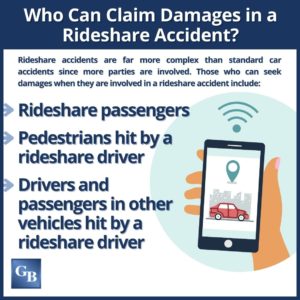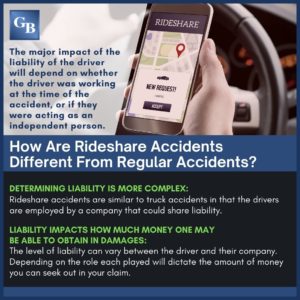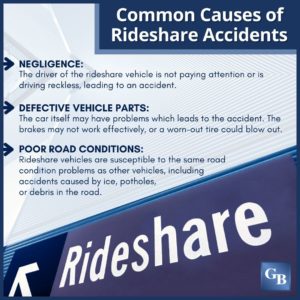Rideshare accidents create challenging and complex liability issues. Both rideshare drivers and rideshare companies may be held liable for damages in a car accident, depending on when the accident occurred. Determining liability requires a skilled legal team with deep experience in accident investigation and settlement negotiation.
Someone who has been injured in a rideshare accident should contact a seasoned lawyer for assistance. For more than 75 years, the Philadelphia car accident lawyers at Galfand Berger LLP have dedicated their energy toward helping injured individuals recover full damages, enabling them to restore their dignity and financial security.
How are Rideshare Accidents Different Than Other Car Accidents?
Collisions involving rideshare drivers are similar to other car accidents in that they may result in serious personal injury and death. Individuals who have been injured in any type of car accident have the right to seek damages from negligent parties. However, rideshare accidents are different than car accidents because of the following factors:
- Determining liability is more complex.
- Liability impacts how much money one may be able to obtain in damages.
In some respects, rideshare accidents are similar to truck accidents when it comes to determining liability. When a passenger car collides with a truck, the trucking company and other third parties may be held liable in addition to the truck driver if the accident was the truck driver’s fault. This is different than a typical accident involving two passenger vehicles, in which drivers are the main parties who may be deemed at fault.
Like trucking companies, rideshare companies may be held liable for damages if the accident was the rideshare driver’s fault. This is true even though rideshare drivers are not technically considered full-time employees of the rideshare company in most states.
Liability depends on whether the rideshare driver was online at the time. In the future, determining liability in rideshare accidents may get even more complicated, should Lyft and Uber pursue their announced plans to add more self-driving cars to their fleets in the United States.

Who can Claim Damages in a Rideshare Accident?
The following individuals may be able to claim damages in a rideshare accident:
- Rideshare passengers
- Pedestrians hit by a rideshare driver
- Drivers and passengers in other vehicles hit by a rideshare driver
Damages may be awarded to pay for medical expenses, loss of income, and pain and suffering. Determining liability for damages in rideshare accidents is a growing concern, as studies indicate that ridesharing services are contributing to more fatal accidents in the United States.
Fatalities Due to Rideshare Accidents
According to a University of Chicago study, rideshare services account for 987 additional fatalities each year in the U.S.
How Much Money can I Obtain for Damages in a Rideshare Accident?
Pedestrians, rideshare passengers, and drivers and passengers in other vehicles hit by a rideshare driver may be able to obtain $1 million in damages if the rideshare driver is found to be at fault for the accident. However, this is true only if the rideshare driver was online and received a trip request. That is because insurance coverage provided by Uber or Lyft fluctuates depending on the driver’s status at the time of the accident. There are three categories of driver status:
- The driver is offline. Drivers who have not activated the Uber or Lyft app are considered offline. Uber and Lyft do not provide any insurance coverage for drivers who are offline. If someone gets into an accident with a rideshare driver who is offline, the amount of damages the victim can recover will typically be limited to that driver’s personal car insurance policy.
- The driver is online but has not received a trip request. In this situation, Uber and Lyft provide limited insurance coverage.
- The driver has accepted a trip request. Uber and Lyft provide at least $1 million in bodily injury coverage if their drivers are found to be at fault in an accident after they accepted a trip request.
Some state and local laws have their own regulations regarding coverage provided by rideshare companies.
What State Laws Govern Ridesharing Company Liability?
In the state of New Jersey, the combination of the rideshare driver’s personal car insurance policy and the rideshare company’s coverage must be at least $1.5 million for death, bodily injury, and property damage.
Pennsylvania also has regulations governing rideshare companies. In the event of an accident in Pennsylvania involving a rideshare driver, the rideshare company must report the accident directly to police officers and the insurance companies. The report must explain whether on not the driver was online and, if so, whether the driver had received a ride request for a prearranged ride. Furthermore, Pennsylvania law states that rideshare companies are required to disclose the precise times when the rideshare driver logged on and logged off of the app during the 12-hour period immediately preceding and in the 12-hour period immediately following the accident and disclose a clear description of the insurance coverage provided during that time.
Are Rideshare Drivers More Prone to Having Car Accidents?
Uber has published statistics suggesting that rideshare drivers are not more prone to having car accidents than other drivers. However, other sources dispute those findings.
Statistics published by Uber include the following:
- There are more than 3 million Uber trips per day in the United States on average.
- The Uber-related motor vehicle fatality rate for 2018 was 0.57 fatalities per 100 million miles traveled, approximately half that of the national rate.
- Approximately 30 percent of fatal accidents involved a pedestrian.
However, other sources indicate that these statistics may be misleading.
For example, the figures provided by Uber only look at fatalities and ignore accidents with serious injuries. Also, the statistics do not include accidents that happen when the Uber driver has the app on but has not yet picked up a passenger.
To help ensure that its rideshare drivers are safe drivers, Lyft performs continuous driving record checks to detect new driving citations. If a driving citation is detected, the rideshare driver is automatically deactivated from access to the Lyft app.
How Common is Drowsy Driving Among Rideshare Drivers?
According to the American Academy of Sleep Medicine (AASM), sleepiness is an inherent risk in the rideshare industry. Drowsy driving is believed to be common among rideshare drivers for the following reasons:
- Rideshare drivers often have another primary job and pick up rideshare passengers during off time.
- Because rideshare drivers are considered independent contractors in most states, federal regulations do not require them to be regularly screened for medical problems that can reduce alertness, as is the case for commercial truck drivers.
Uber and Lyft now impose rest periods after a shift of driving. However, this may not be enough to prevent drowsy driving, especially because many rideshare drivers are working long hours in other jobs and often pick up rideshare passengers late at night when sleepiness tends to peak.
Drowsy driving is a national problem. It is estimated that more than 300,000 car accidents a year are due to drowsy driving.
What is Involved in Determining Liability in Accidents with Self-Driving Vehicles?
Determining liability in accidents with self-driving vehicles can be quite complex, involving the following issues:
- Negligence of the driver
- Liability of the rideshare company
- Products liability on the part of the vehicle manufacturer
In the case of the fatal Uber accident in Arizona, the car’s self-driving system software detected the pedestrian 5.6 seconds before she was struck, but its algorithms failed to accurately predict her path and identify her as a pedestrian because she was walking with a bicycle. The failure of the software system suggests that the vehicle manufacturer was negligent in selling a defective product. According to a report by the National Transportation Safety Board (NTSB), the manufacturer, Uber Advanced Technologies Group, did not adequately manage the anticipated safety risk of its automated driving system’s functional limitations.
At the same time, there was a human driver present in the car. The role of this driver was to disengage the automatic pilot system and take over the wheel in the event of a dangerous situation. However, driver was not watching the road when the accident happened because she was looking at her cell phone. This would suggest negligence on the part of the driver.
There are likely other potentially complicated legal questions that may arise should accidents occur involving self-driving vehicles operated by ridesharing services.

91,000 Crashes Per Year
The National Highway Traffic Safety Administration reports that 91,000 drowsy driving accidents occur each year.
Why are Uber and Lyft Investing in Self-Driving Car Fleets?
Uber and Lyft have invested in self-driving car fleets because more than 90 percent of accidents are caused by driver error. Lyft has announced plans to deploy fully self-driving vehicles in multiple cities throughout the U.S. by 2023.
According to Lyft, there have already been more than 100,000 self-driving rides using the Lyft app in the United States.
LYFT: Over 100,000 Self-Driving Rides so Far
Uber had initially launched an ambitious self-driving car venture that was put on hold after a fatal accident in 2018. In that incident, a self-driving Uber car killed a pedestrian who was jaywalking with a bicycle at night in Tempe, Arizona. The computer system of the vehicle interpreted the person as riding the bicycle and miscalculated distance and speed needed to avoid a collision. Uber subsequently suspended many of its self-driving car tests across the United States after the incident. However, California has approved a permit for Uber to resume testing of self-driving vehicles.

How Have Uber and Lyft Addressed Drowsy Driving?
The business model of Uber and Lyft encourages drivers to spend long hours in their car in order to get more fares. To address drowsy driving, Uber and Lyft have modified their apps to impose driving time limits.
In 2018, Uber modified its app to restrict drivers to a 12-hour driving time limit:
- The app notifies drivers that the limit is approaching.
- The app automatically goes offline after 12 hours.
- After six hours, driving time resets and drivers can go online again.
Lyft requires drivers to take a six-hour break when the app has been in driver mode for 14 hours.
However, in reality, these restrictions cannot prevent drowsy driving among rideshare drivers. Many Uber drivers also drive for Lyft, and if their app goes offline, they can just switch to another app. Also, six hours is not really enough time for a full night sleep.
In contrast, federal regulations require local commercial truck drivers to have a least a 10-hour break between their shifts. There are stiff penalties for trucking companies that violate hours of service (HOS) rules.
Should I Call a Lawyer if I am in a Rideshare Accident?
Anyone involved in a rideshare accident should call a lawyer as soon as possible.
Philadelphia Car Accident Lawyers at Galfand Berger LLP Seek Justice for Victims of Car Accidents
If you were injured in a car accident, do not hesitate to contact the Philadelphia car accident lawyers at Galfand Berger LLP. We will determine who is responsible for causing the accident and ensure that you receive the assistance you deserve. Our dedicated team will explain the claims process and address all your questions and concerns. For a free consultation, call 800-222-8792 or contact us online. From our offices in Philadelphia, Bethlehem, Lancaster, and Reading, Pennsylvania, we proudly help clients throughout Pennsylvania and New Jersey, including Allentown and Harrisburg.
 Google Screened
Google Screened
